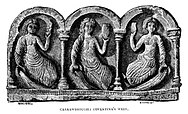
Back Druïdisme Afrikaans Druida AN درويد Arabic Druidismu AST Druid BAR Друіды Byelorussian Друид Bulgarian দ্রূইদ Bengali/Bangla Drouiz Breton Druidi BS

| Part of a series on |
| Celtic mythologies |
|---|
 |
A druid was a member of the high-ranking priestly class in ancient Celtic cultures. Druids were religious leaders as well as legal authorities, adjudicators, lorekeepers, medical professionals and political advisors. Druids left no written accounts. While they were reported to have been literate, they are believed to have been prevented by doctrine from recording their knowledge in written form. Their beliefs and practices are attested in some detail by their contemporaries from other cultures, such as the Romans and the Greeks.
The earliest known references to the druids date to the 4th century BC. The oldest detailed description comes from Julius Caesar's Commentarii de Bello Gallico (50s BCE). They were described by other Roman writers such as Cicero,[2] Tacitus,[3] and Pliny the Elder.[4] Following the Roman invasion of Gaul, the druid orders were suppressed by the Roman government under the 1st-century CE emperors Tiberius and Claudius, and had disappeared from the written record by the 2nd century.
In about 750 AD, the word druid appears in a poem by Blathmac, who wrote about Jesus, saying that he was "better than a prophet, more knowledgeable than every druid, a king who was a bishop and a complete sage."[5] The druids often appear in both the tales from Irish mythology first written down by monks and nuns of the Celtic Church like the "Táin Bó Cúailnge" (12th century), but also in later Christian legends where they are largely portrayed as sorcerers who opposed the introduction of Christianity by missionaries.[6] In the wake of the Celtic revival during the 18th and 19th centuries, fraternal and neopagan groups were founded based on ideas about the ancient druids, a movement known as Neo-Druidism. Many popular notions about druids, based on misconceptions of 18th-century scholars, have been largely superseded by more recent study.[7]
- ^ de Montfaucon, Bernard. Antiquitas explanatione et schematibus illustrata. vol. ii, part ii, book V. p. 436.
- ^ Cicero (44) I.XVI.90.
- ^ Tacitus XIV.30.
- ^ Pliny (c. 78) XVI.249.
- ^ Mac Mathúna, Liam (1999). "Irish Perceptions of the Cosmos" (PDF). Celtica. 23: 174–187, esp. 181.
- ^ Hutton (2009) pp. 32–37.
- ^ "The Druids". The British Museum. Archived from the original on 25 February 2015. Retrieved 11 February 2016.